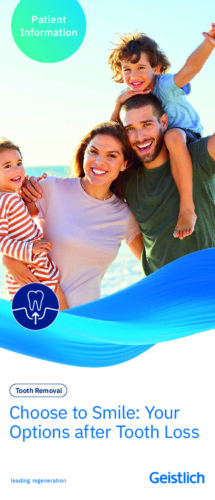When do you use the large Geistlich Bio-Oss® particles (1-2 mm) and when do you use the small particles (0.25-1 mm)?
Fundamentally, the use of small particles is recommended for small defects (up to 2 dental alveoli) and for augmenting autogenous grafts. The large particles are recommended for large defects (> 2 dental alveoli, sinus lifts), however, preferences can vary from dentist to dentist.
Can Geistlich Bio-Oss® or Geistlich Bio-Oss Pen® also be used without membrane?
A membrane should be used in conjunction with Geistlich Bio-Oss® or Geistlich Bio-Oss Pen® as a barrier against the ingrowth of soft tissue1. Native collagen membranes such as Geistlich Bio-Gide® also promote wound healing and increase therapeutic safety in the event of a postoperative wound dehiscence2,3. Clinicians should read the package insert prior to use.
- Gielkens PF, et al.: Clin Oral Implants Res 2008; 19(5) : 516-21.
- Tal H, et al.: Clin Oral Implants Res 2008; 19(3): 295-302.
- Becker J, et al.: Clin Oral Implants Res 2009; 20(7): 742-49
Can Geistlich Bio-Oss® or Geistlich Bio-Oss Pen® be re-sterilized?
No. If Geistlich Bio-Oss® is autoclaved, moisture can collect in the particles due to the high porosity of the product, which can change the hydrophilic properties. Moreover, Geistlich Bio-Oss® is not approved for re-sterilization. Re-sterilization under any circumstances is not recommended.
Should Geistlich Bio-Oss® be mixed with antibiotics?
The use of local antibiotics is generally unnecessary when utilizing Geistlich Bio-Oss®.
Is Geistlich Bio-Oss® safe (transmission of diseases such as Bovine Spongiform Encepholapathy (BSE)?
Geistlich Bio-Oss® is made from the mineral part of bovine bone. The strictly controlled manufacturing process ensures high quality and safety standards by:
- country of origin: Switzerland, Australia (and for some countries also New Zealand), which is historically and currently free of BSE
- defined origin of the raw material
- selected and certified slaughterhouses
- pre- and post-mortem health inspection for each individual animal
- extremity bone (according to WHO Guideline on tissue infectivity classified as tissues with no detected infectivity or infectious prions)
- effective inactivation methods with 15h treatment at high temperature and cleaning with strong alkaline solutions
- sterilization, double sterile packaging
- official controls by international authorities
Do I have to use venous blood or can I use blood from the defect?
Blood from the defect may be used for mixing. Care should be taken to avoid contamination with salivary bacteria.
How much saline or blood is needed to moisten the Geistlich Bio-Oss Pen®?
0.25 cc Geistlich Bio-Oss Pen®: ~0.25 ml
0.5 cc Geistlich Bio-Oss Pen®: ~0.5 ml
How many Geistlich Bio-Oss Pen® delivery systems are needed for a sinus floor elevation?
Depending on the size of the defect, between 1.5 to 4 cc of Geistlich Bio-Oss® granules are needed, 3cc on average.
Can the Geistlich Bio-Oss® granules be mixed with autologous bone in the Geistlich Bio-Oss Pen®?
No, Geistlich does not recommend mixing autologous bone with the Geistlich Bio-Oss® granules within the syringe.
If the applicator tip is contaminated (e.g. has fallen on the floor) can it be re-used?
No. Discard and use a new Geistlich Bio-Oss Pen®.
Can separate applicator tips be ordered?
No. The applicator tips are not available separately.
Are other applicator tips (forms, length, diameter) available?
No. There are no other tips available.
How do I access the IFUs for Geistlich products?
The IFUs for Geistlich products can be found using this page.












